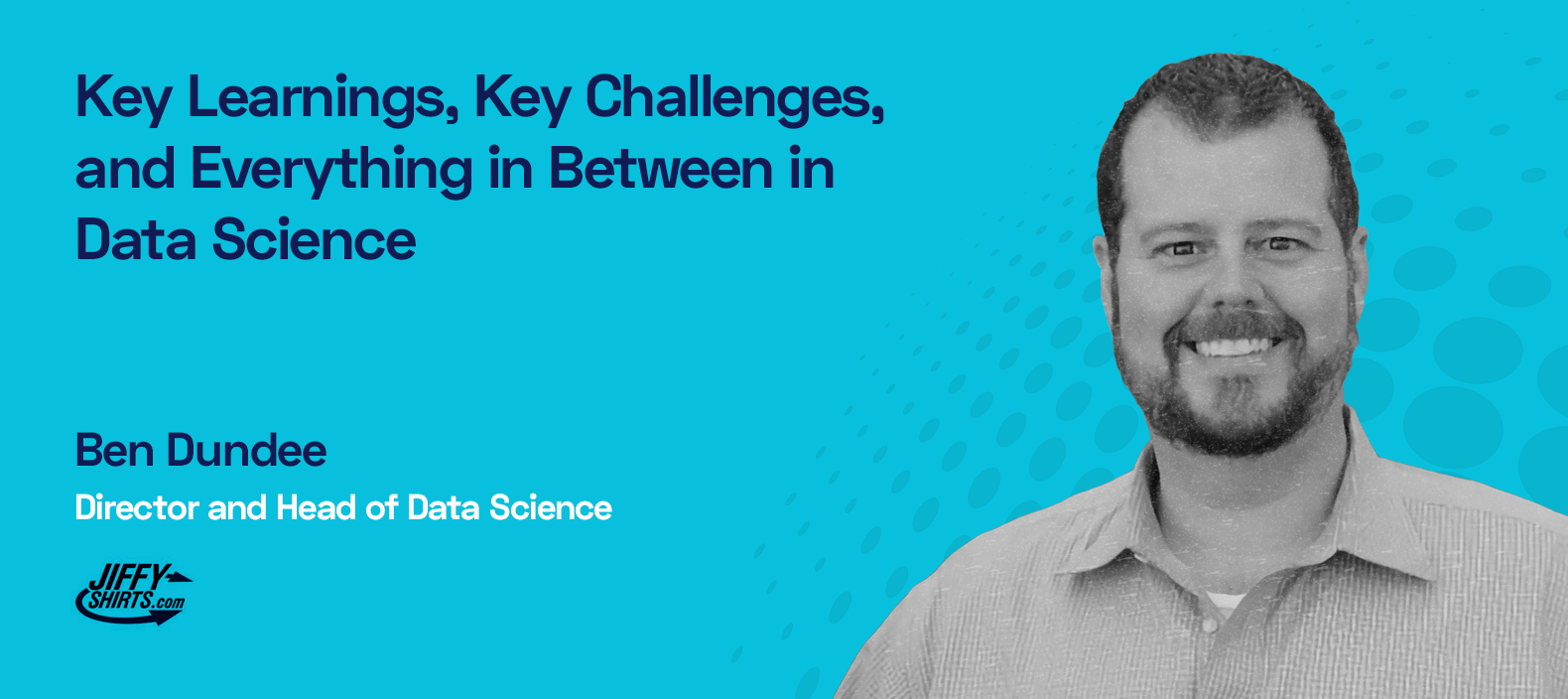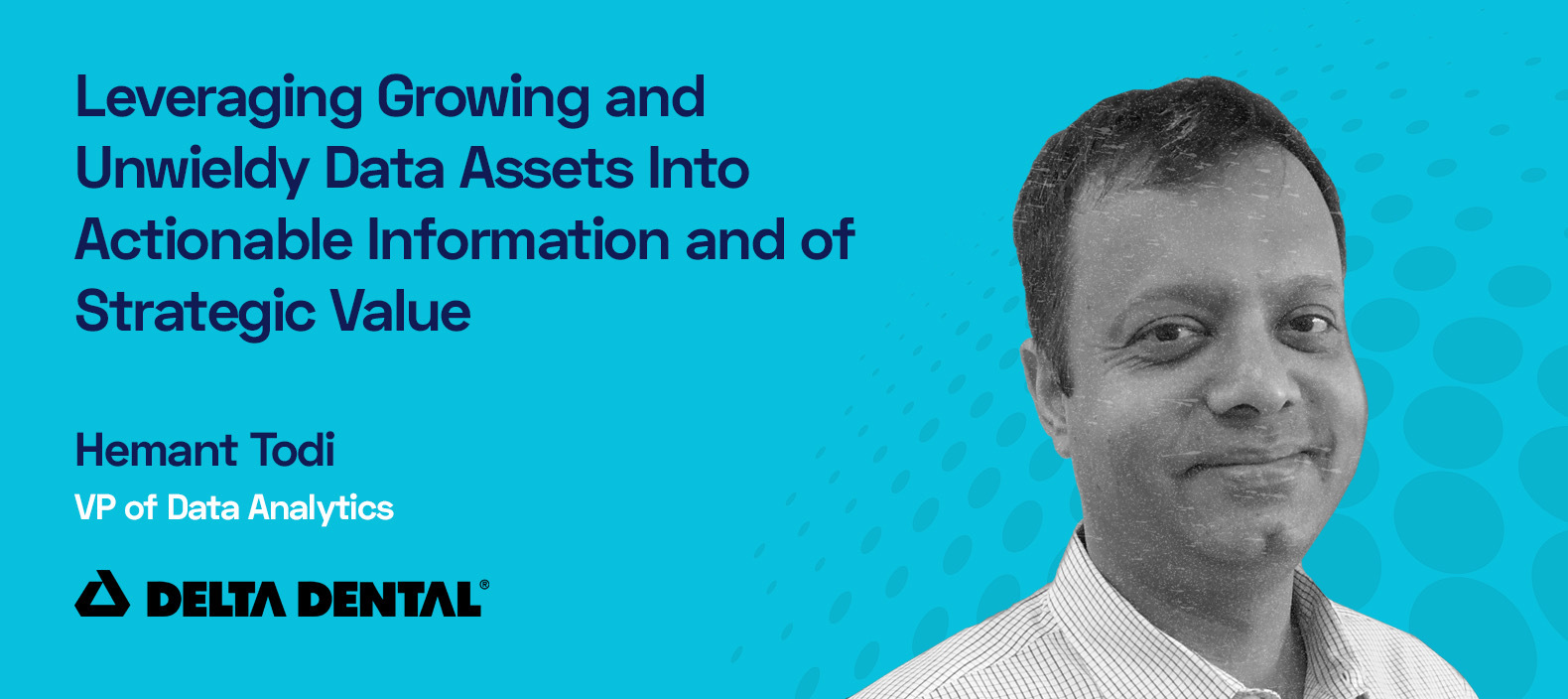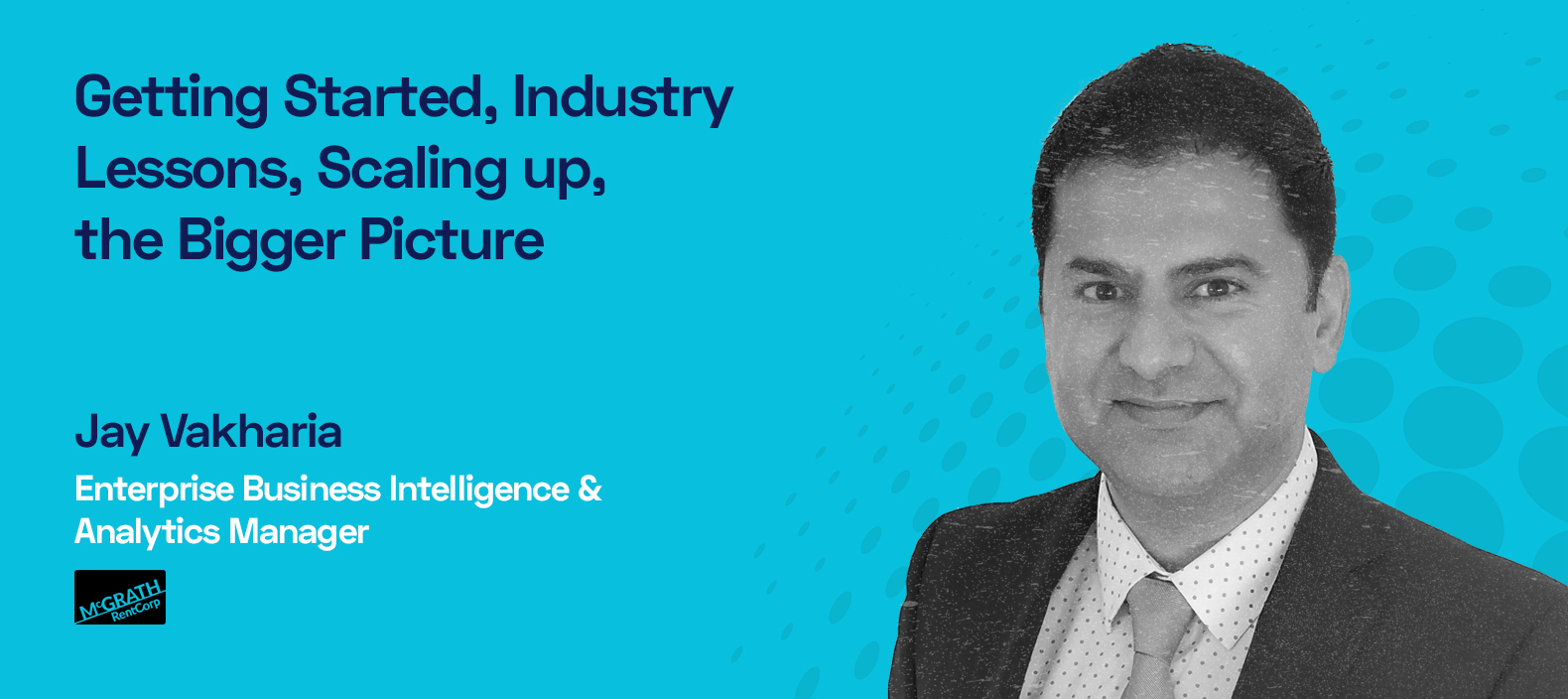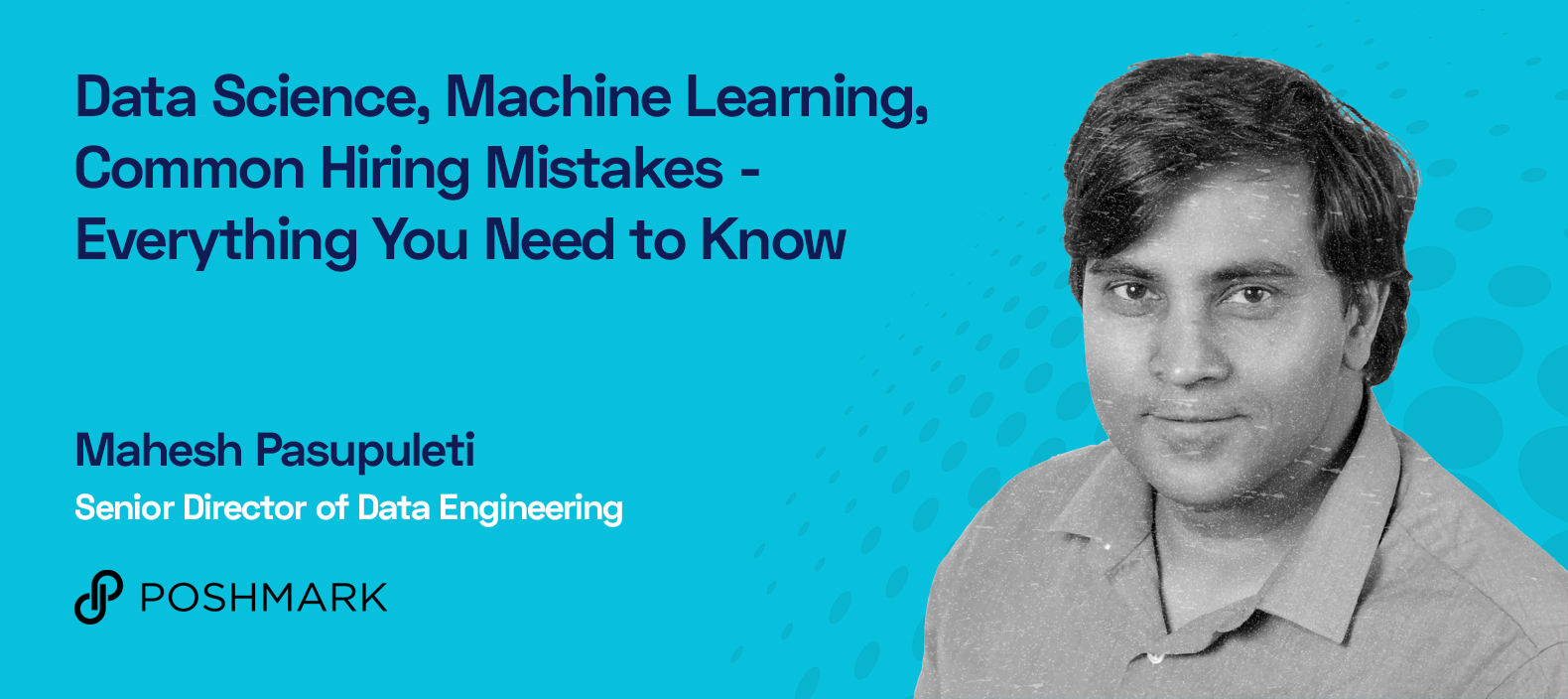The Interview with the Hiring Manager series from DataMatrix aims to provide aspiring data science, engineering & analyst candidates a glimpse of how potential hiring managers view the field. In this series, Hiring Managers share best practices, tips & feedback for prospective candidates.
This week, we speak to Ben Dundee1, Director and Head of Data Science at JiffyShirts.com. Ben began his career as a Quantitative Analyst, valuing credit derivatives at FINCAD. He then moved into data science with different start-ups, with stints in product management at Square Root, Inc and business analytics at RetailMeNot. More recently, Ben led the Ranking and Relevance team at Vrbo, an Expedia group company, before moving to JiffyShirts.com.
Could you tell us a little bit about your career journey and what brought you into data science?
When I came out of graduate school in 2010, I was pretty sure I didn’t want to go into academia. So, I went to work for a financial software company in Vancouver, British Columbia called FINCAD, valuing credit derivatives. In 2012, I returned to Texas after I was laid off because of downsizing. I got into data science because I was at the right time and place.
That time was like the wild west of data science, and I became a data scientist by calling myself one. Fortunately, I had the right skill set, used the right words, and got hired as a data scientist at a start-up. While I didn’t have direct data science experience (no one really did in 2012), I had a lot of experience in looking at problems, breaking them down, and stating them mathematically. Everyone hates the word problems in standardized tests. But, in the real world, you only ever get word problems. And sometimes they don’t have numbers in them, and you have to figure out how to measure different things. So, that is a core competency as a data scientist that cannot be taught, that you have to learn for yourself.
From there, I moved to product management for a while. That was a hugely formative and beneficial experience for me. I worked at a company called RetailMeNot, leading a business analytics team. That taught me how to apply what I’d learned about the business as a product manager, which helped improve the quality of my work as an analyst. I then moved to Vrbo, which is a part of Expedia group, and managed the team that owned the core ranking algorithm on vrbo.com. That role taught me what it was like to operate at scale — millions of users a day, and billions of dollars in revenue. More recently, I’ve taken a position leading all data science and analytics at a small and growing company, JiffyShirts.com.
What are some of the key learnings that you've drawn from the field of data science and what are some of the key shifts that you've mapped?
For me, the guiding light is simplicity—how simple can we make our solutions. The fancier you make these solutions, the harder they are to debug. And if you are using a neural network, you just have to throw your hands up in the air when some VP demands to know how the model makes its decisions.
If you can get away with a logistic regression or use a moving average that > you can slap in with six lines of code, then you should just use that. At the > end of the day, keeping a focus on what the business wants, the business’s > expectations and trade-offs, are valuable things for data scientists.
The other thing I’ve learned is that you should prefer open-source, out-of-the-box solutions instead of rolling out your own. On the ranking team at Vrbo, we used LightGBM for gradient boosted decision trees. Yandex, the Russian search engine giant, uses Catboost in production. Using those optimized pieces of code that have large open-source communities deployed and running in production in a lot of places just makes sense.
The last learning that I will call out is a mistake I’ve made myself and that I see junior people making too. Surprises are always bad. You are never going to walk into a meeting and produce results that nobody expected, and have it end well. It’s important to understand your stakeholders, communicate with them, and make sure you are checking in with them. People have to know the direction you are going in, the things that you are finding. And then you can have a discussion about what to do next.
What are some of the most exciting aspects of building and managing a data science team?
Innovation and creativity are about connecting dots. So, you have to get a bunch of people together who know about different dots. If I am looking at somebody who also came from a physics background, worked at startups, and was a product manager, that person has really similar experiences to me and is unlikely to bring in anything new. The highest performing teams I’ve worked with have always benefitted from a diversity of backgrounds and perspectives. You have to have some people with PhDs and some who are Kaggle competitors. Ultimately, the value a data scientist provides depends on how they look at a problem, it’s awesome to see a group of smart people look at a problem in several completely different ways.
And when you have a bunch of people all looking at hard problems in different ways, you tend to get amazing solutions that generate incredible value for the business. In the first week of my current role, I found five or six huge analytics opportunities, and it’s just a matter of getting to them. I guess I just love getting paid to figure stuff out.
What are the key challenges you’ve faced in building and managing a data science team?
For me, the key challenge is getting the right people. At the end of the day, the biggest concern for me is the team. I am much happier to have people who perform at a slightly lower level but bring something to the team than people who perform at a much higher level but don’t make the people around them better. You have to think about data science as a team sport.
Another thing is that the government requires the consent of the governed, as some philosopher said. I’m not the kind of manager who will tell my team what to do. They are too smart and too employable for that. So, I work to build capital with people, let them know I’m on their side, have their best interests at heart, and am pointing them in the right direction to keep the business happy. Once you build that environment, it becomes a lot easier to have those discussions where you have to convince somebody to do something.
The last challenge involves what I would say is the primary role of the data science manager: to create breathing room for the team. As a data science team, if your time is fully committed, if your bandwidth is 100% spoken for, then you are not doing any of the things that data scientists should be doing. Like fixing technical debt or thinking ahead to things with low probability but high payouts and trying out some of that. You should really be spending 10% or 20% of your time as a data scientist doing that. Part of the manager’s job is to set the expectations with the business that you have to hold back some bandwidth to have something bigger and better down the road.
To be clear, there are times when you’ll need to dedicate 100% of your bandwidth. Sometimes “bigger and better down the road” is not as important as “smaller and pretty good right now”. There was a lot of that this year, in March and April when the first lockdowns hit. Some people operate very well in crunch, but many don’t. This year, everyone experienced it at one time or another. You have to be mindful of that as a leader, and this is where the personal capital helps. My message for the team in 2020 was “we’re all here together”.
What are the biggest mistakes companies can make during the hiring process that result in a bad hire or drive away valuable talent?
I am going to steal an analogy from a data scientist and standup comedian I met at a conference. When hiring a data science team, the CEO thinks he wants a Ferrari. But the data science manager knows that’s not what he needs. For driving back and forth to work on roads with a speed limit of 50, he needs a Camry that is going to be his workhorse.
There was a fantastic data scientist at one of the organizations I worked for, who came in as a Ferrari and was told to go find the biggest opportunity. But the biggest opportunity for him to deliver value to the business threatened the largest team in terms of headcount, and which had the deepest relationship with the CEO. So, they did a project, but it didn’t deliver its full value because people stood in his way. He was there for a couple of months and then went back to his previous employer. That was a tremendous waste of time and money.
The second kind of big mistake I’ve seen is not preparing your organization for change. A lot of times, data science is a big cultural change. The job is to sacrifice sacred cows. But sacred cows are sacred to somebody. You want to make sure that the organization is ready and that you have clear, crisp use cases ready for them when you start hiring your first few data scientists.
As for the hiring process itself, when you are hiring for junior data scientists, you get swamped by resumes. So, I would say that finding the few candidates who really stand out for entry level roles has been challenging.
If someone is applying to be a data scientist at JiffyShirts.com, what can they look forward to from a process perspective?
We’re pretty light as far as the process goes. There is an initial screen, a take-home problem, and then an interview with the team. There are a ton of opportunities here, and the company is growing pretty quickly.
Primarily, we are looking for people who can take on an analytics-heavy role in the beginning, but who can help us drive the team towards bigger problems with longer term value. There’s no part of the business that the current team doesn’t touch, which means that we have a view of the company that few others do. It is really a fantastic opportunity to spend time thoroughly understanding the system you’re trying to model.
When you look at a candidate’s resume, what are some must-have requirements that you look for?
I really want to see the problems that people have solved. I don’t need to see a detailed list of everything, but I want something more than the four capstone projects that you had in your 13-month data science accelerator. Those are table stakes. I want to see problems that you solved by yourself. I don’t want to see problems where you had the outline of a solution and you cut and paste code into a notebook and filled in some blanks.
The other thing that I want to see, though I understand that this is hard for entry-level resumes, is applicants quantifying things. If I see a bullet point where you have quantified something—like improving a metric by 5%—versus saying that you led a project and had excellent people managing skills, both are interesting and relevant facts. But I care a lot more about the first one, where you have actually quantified something.
I also feel that people sometimes want to make entry-level resumes longer. If your entry-level resume is two pages long, I probably won’t spend a lot of time on the second page. So, focus on getting one good page of content. Keep in mind that the resume is only a tool to get you a job interview. So, you should put as much effort into it as you think is needed to get you a job interview.
Also, I am going to put a lot of language in the job description that says exactly what I want. So, tailoring your resume to a job description is very important, which people don’t realize very often.
During interviews, what are some things you want to hear from a candidate that would convince you to hire them?
I am big on the soft skills aspects—communication, people management, and stakeholder management. Those are things that I am going to interview for. When you go into a soft skills interview, there are some canned responses that you should have ready to go. To the extent that you don’t, it just means that you are not prepared for the interview.
If you mention a project on your resume and I get confused when you explain it, that’s bad news. Make sure that you can talk through everything in your resume.
It’s also really important to me that employment is a two-way agreement. I want to feel like the person is interviewing me as well. If people come in for interviews and they don’t have any questions, that is a big red flag for me.
Finally, I’m big on diversity. I ‘m big on seeing how a person is different from the people that we have. As I mentioned, it’s about different perspectives and different backgrounds, leading to a different view of the problem the team is trying to solve.
What tips and strategies would you give to a prospective candidate on how best to apply and interview with you?
What vital skills do you think young data scientists should focus on developing? What kind of experience should they be looking to get under their belt?
The universities and accelerators generally do a really good job of the technical know-how. But they are not great at teaching the soft skills or the communication aspect. A Chief Product Officer of a former company once told me that he took a lot of technical courses on analytics, finance, and so on in business school. But what has stood his way since then, what he wished he had done more of, was courses on the organizational skills needed to push projects forward. Business schools have these courses, but a lot of data science programs do not. I spent two years as a product manager and that has been the most valuable data science training I could have, because it helped me understand how to communicate, specifically how to communicate with executive stakeholders. As an entry-level data scientist, you are obviously not going to be able to have that experience. But what I do want to see is how you communicate, how you talk about what you have done.
Also, it’s important whether you talk to me as a data science manager or as a person. If I ask you about your dissertation or some other project, I don’t want you to immediately dive into the technical stuff. I really want to be able to hear people communicate in a way that doesn’t rely on technical expertise or a technical education to be understood.
How can candidates who are early in their data science careers and don’t have a lot of previous experience stand out from the crowd?
Perhaps the first person I hired as a data scientist had a blog on which he would pick a different problem each week and solve it. For instance, when we were having a drought in Austin, he wrote code and carried out simulations to model how much rain was needed and where to fill up Lake Travis, the main water reservoir for the city. To me, that is the curiosity you have to have to become a great data scientist.
One of the projects I worked on when I was first starting to be a data scientist was to model my fantasy football team to predict the best players for me to acquire off the bench. I also have some code that scrapes Texas Parks and Wildlife fishing reports and provides a quick report on where the fishing is good.
Find something that you are interested in and find a way to apply data to it. More than anything else, that shows me that you care about this field, about solving these kinds of problems.
What are some of the problem spaces that your team at JiffyShirts are exploring that you think candidates might find exciting?
What’s really exciting about JiffyShirts is that, in spite of being an established e-commerce player, the role of data and analytics is still being fleshed out. I haven’t been at this new role long, and I already have a request from just about everyone in the company — it’s only a question of how quickly we can build the team to go and tackle those opportunities.
The company has made great strides in the past on the canonical use cases for data science in e-commerce. But there’s still much to be done here — search/ranking and recommendation, and how to balance the interests of the business, our suppliers, and the customer during the discovery phase of the purchase. Jiffy’s brand promise is fast shipping and low prices, so ensuring that we’re competitive on prices and that we can profitably fill orders are also two huge areas of opportunity.
Marketing, customer success (another area that Jiffy consistently wins over its competitors), supplier relationships, new lines of business, personalization, AB testing… I could go on at some length here. Suffice it to say, this is an incredibly exciting time for Jiffy, and I am looking forward to finding a team of people who are keen on making an impact.








